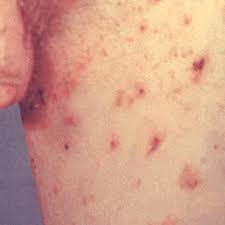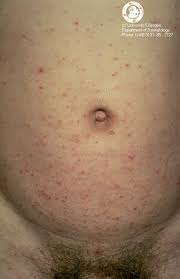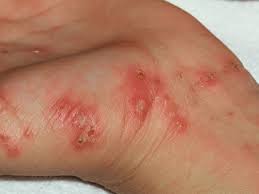Scabies
What is scabies?
Human scabies is caused by an infestation of the skin by the human itch mite (Sarcoptes scabiei var. hominis). The microscopic scabies mite burrows into the upper layer of the skin where it lives and lays its eggs. The most common symptoms of scabies are intense itching and a pimple-like skin rash. The scabies mite usually is spread by direct, prolonged, skin-to-skin contact with a person who has scabies.
Scabies occurs worldwide and affects people of all races and social classes. Scabies can spread rapidly under crowded conditions where close body contact is frequent. Institutions such as nursing homes, extended-care facilities, and prisons are often sites of scabies outbreaks.
Scabies is a common condition found worldwide; it affects people of all races and social classes. Scabies can spread easily under crowded conditions where close body and skin contact is common. Institutions such as nursing homes, extended-care facilities, and prisons are often sites of scabies outbreaks. Child care facilities also are a common site of scabies infestations.
If a person has had scabies before, symptoms appear much sooner (1-4 days) after exposure. An infested person can transmit scabies, even if they do not have symptoms, until they are successfully treated and the mites and eggs are destroyed.

 The most common symptoms of scabies, itching and a skin rash, are caused by sensitization (a type of “allergic” reaction) to the proteins and feces of the parasite. Severe itching (pruritus), especially at night, is the earliest and most common symptom of scabies. A pimple-like (papular) itchy (pruritic) “scabies rash” is also common. Itching and rash may affect much of the body or be limited to common sites such as:
The most common symptoms of scabies, itching and a skin rash, are caused by sensitization (a type of “allergic” reaction) to the proteins and feces of the parasite. Severe itching (pruritus), especially at night, is the earliest and most common symptom of scabies. A pimple-like (papular) itchy (pruritic) “scabies rash” is also common. Itching and rash may affect much of the body or be limited to common sites such as:
Tiny burrows sometimes are seen on the skin; these are caused by the female scabies mite tunneling just beneath the surface of the skin. These burrows appear as tiny raised and crooked (serpiginous) grayish-white or skin-colored lines on the skin surface. Because mites are often few in number (only 10-15 mites per person), these burrows may be difficult to find. They are found most often in the webbing between the fingers, in the skin folds on the wrist, elbow, or knee, and on the penis, breast, or shoulder blades.
Cleaning the environment should include:
Scabies occurs worldwide and affects people of all races and social classes. Scabies can spread rapidly under crowded conditions where close body contact is frequent. Institutions such as nursing homes, extended-care facilities, and prisons are often sites of scabies outbreaks.
Transmission
Human scabies is caused by an infestation of the skin by the human itch mite (Sarcoptes scabiei var. hominis). The adult female scabies mites burrow into the upper layer of the skin (epidermis) where they live and deposit their eggs. The microscopic scabies mite almost always is passed by direct, prolonged, skin-to-skin contact with a person who already is infested. An infested person can spread scabies even if he or she has no symptoms. Humans are the source of infestation; animals do not spread human scabies.Persons At Risk
Scabies can be passed easily by an infested person to his or her household members and sexual partners. Scabies in adults frequently is sexually acquired.Scabies is a common condition found worldwide; it affects people of all races and social classes. Scabies can spread easily under crowded conditions where close body and skin contact is common. Institutions such as nursing homes, extended-care facilities, and prisons are often sites of scabies outbreaks. Child care facilities also are a common site of scabies infestations.
Symptoms
When a person is infested with scabies mites the first time, symptoms usually do not appear for up to two months (2-6 weeks) after being infested; however, an infested person still can spread scabies during this time even though he/she does not have symptoms.If a person has had scabies before, symptoms appear much sooner (1-4 days) after exposure. An infested person can transmit scabies, even if they do not have symptoms, until they are successfully treated and the mites and eggs are destroyed.
Common Symptoms

 The most common symptoms of scabies, itching and a skin rash, are caused by sensitization (a type of “allergic” reaction) to the proteins and feces of the parasite. Severe itching (pruritus), especially at night, is the earliest and most common symptom of scabies. A pimple-like (papular) itchy (pruritic) “scabies rash” is also common. Itching and rash may affect much of the body or be limited to common sites such as:
The most common symptoms of scabies, itching and a skin rash, are caused by sensitization (a type of “allergic” reaction) to the proteins and feces of the parasite. Severe itching (pruritus), especially at night, is the earliest and most common symptom of scabies. A pimple-like (papular) itchy (pruritic) “scabies rash” is also common. Itching and rash may affect much of the body or be limited to common sites such as:- between the fingers,
- wrist,
- elbow,
- armpit,
- penis,
- nipple,
- waist,
- buttocks,
- shoulder blades.
Tiny burrows sometimes are seen on the skin; these are caused by the female scabies mite tunneling just beneath the surface of the skin. These burrows appear as tiny raised and crooked (serpiginous) grayish-white or skin-colored lines on the skin surface. Because mites are often few in number (only 10-15 mites per person), these burrows may be difficult to find. They are found most often in the webbing between the fingers, in the skin folds on the wrist, elbow, or knee, and on the penis, breast, or shoulder blades.
Medications
- Sulphur has been used since around 25 AD to treat Scabies. You can find bar soap with sulfur in the ranges of 1%-10% to kill scabies, it's recommended you go with 6% or above. Wash whole body once daily for 4 days. It is still recommended that you wash all clothing and bedclothes in hot water and tumble dry on hot as with Permethrin. However, this treatment is largely ineffective.
Topical drugs
- Permethrin 5% is topical medication of choice. Toxicity may resemble allergic reactions. It is usually applied to the skin before bedtime and left on for about 8 to 14 hours, then showered off in the morning. Package directions or doctor's instructions should be followed, but one application is normally sufficient to cure an infection
- Eurax (USP Crotamiton) This is not a cure but helps to relieve itch (pruritis)
- Malathion: Applied for 24 hours; effective in killing both adults and eggs.
- Lindane lotion is approved in the U.S. for use as a second-line treatment where first-line medications like permethrin have either failed, are not well tolerated or otherwise contraindicated It is illegal in 17 other countries, and 33 more countries have restricted its use. Though rare, serious side effects have resulted from product misuse.The FDA has confirmed 3 deaths that all involved use of lindane not in accordance with the label, including excessive topical applications and oral ingestions.
- There is some evidence that a 10% sulfur ointment in petroleum jelly applied topically is effective. It is cheap and readily available over-the-counter. It also has the advantage of being able to be used in pregnant women and infants under two months of age.
- Neem oil is deemed very effective in the treatment of scabies although only preliminary scientific proof exists which still has to be corroborated, and is recommended for those who are sensitive to permethrin, a known insecticide which might be an irritant. Also, the scabies mite has yet to become resistant to neem, so in persistent cases neem has been shown to be very effective.
- vitro situation.
Oral
A single dose of Ivermectin has been reported to reduce the load of scabies but another dose is required after 2 weeks for full eradication. In 1999, a small scale test comparing topically applied Lindane to orally administered Ivermectin found no statistically significant differences between the two treatments. As Ivermectin is easily administered (not requiring a rub down of the whole body like lindane or permethrin twice per treatment), compliance is much better. Ivermectin is used in eradication programs of many parasites of both human and animal. Side effects may include mild abdominal pain, nausea, vomiting, myalgia and/or arthralgia, which subside. The product is considered safe for use in children over five months of age.Public health and prevention strategies
There is no vaccine available for scabies, nor are there any proven causative risk factors. Therefore, most strategies focus on preventing re-infection. All family and close contacts should be treated at the same time, even if asymptomatic. Cleaning of environment should occur simultaneously, as there is a risk of reinfection. Therefore it is recommended to wash and hot iron all material (such as clothes, bedding, and towels) that has been in contact with scabies infestation.Cleaning the environment should include:
- Treatment of furniture and bedding.
- Vacuuming floors, carpets, and rugs.
- Disinfecting floor and bathroom surfaces by mopping.
- Cleaning the shower/bath tub after each use.
- Daily washing of recently worn clothes, towels and bedding in hot water, drying in a hot dryer and steam ironing.



No comments:
Post a Comment